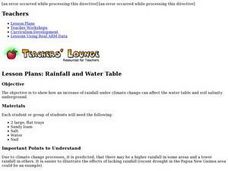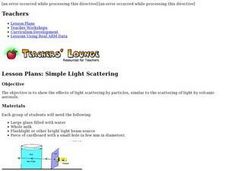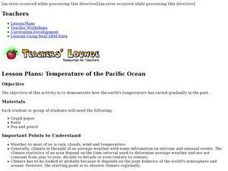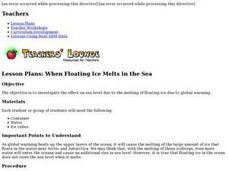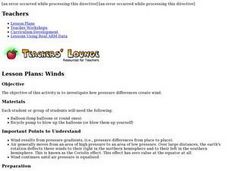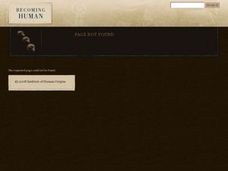Curated OER
ESTIMATING LOCAL SEA LEVEL
Students observe the local environment based upon the sea level variations and examine many clues which can indicate sea level change.
Curated OER
Global Warming
This contains a writing prompt about global warming that could be adapted in a number of ways. The resource provides some information about global warming and possible effects. Learners explore the enhanced greenhouse effect and the...
Curated OER
Historical Climate Statistics
Are we getting hotter? Let’s look at a sample locality where historical records exist and see what we can find out. Here is an activity that has young environmentalists plotting the average winter temperature in England from 900-1900. It...
Curated OER
Microclimate
Learners identify, measure, and average microclimatic temperatures in a particular region. Groups of students are assigned a certain are to be sampled out on the playground, and other areas around the school campus. They record their...
Curated OER
Outgassing
Students demonstrate the concept of outgassing and to explain the origins of the earth's atmosphere. They perform a simple experiment using glass jars, two antacid tablets, and some water. This experiment does a good job in demonstrating...
Curated OER
Plant Growth and Carbon Dioxide
Young scientists show how carbon dioxide in the air affects plant growth. This math and science lesson provides a good platform for learners to combine scientific knowledge with mathematical representation of data. A simple, yet...
Curated OER
Rainfall and Water Table
Through inquiry, experimentation, and observation, young scientists see how an increase in rainfall under climate change can affect the water table and soil salinity underground. Young scientists build models that represent the...
Curated OER
Rate of Coral Growth
Using a table of information provided, middle school marine biologists chart data on a graph to determine the impact of water depth on coral growth in Australia's Great Barrier Reef. Then they answer questions that connect the data to...
Curated OER
Reason for the Seasons
Young scientists examine why we have seasons on Earth, and how the motion of the Earth around the Sun causes them. Groups of learners are given a variety of balls, a bamboo stick, a marker, and a flashlight, then use the objects to...
Curated OER
Sea Water and Agriculture
Young scientists examine how even a small rise in sea level can lead to salinisation of valuable agricultural land. First, everyone takes part in a simple demonstration which shows the negative effects salt water has on plants. Peer...
Curated OER
Simple Light Scattering
Young scientists show the effects of light scattering by particles; which is similar to the scattering of light by volcanic aerosols. Groups of learners work together to conduct this simple, but illuminating demonstration. The follow-up...
Curated OER
Temperature of the Pacific Ocean
Young scientists demonstrate how the Earth's temperature has varied gradually in the past. They attempt to answer four questions which all pertain to how the Pacific Ocean's temperature has evolved over time. Internet research, and a...
Curated OER
The Pacific and El Niño
El Nino, and the climate changes that go along with it, are the focus of this Earth Science instructional activity. Learners pay particular attention to the wind patterns that are established on Earth, and look at weather maps to see how...
Curated OER
Weather and Climate Statistics
The investigation of weather, and climate is a fascinating study. In this lesson, learners see how weather and climate are actually two very different areas of study. They study printouts of an areas temperature highs, lows, and average...
Curated OER
When Floating Ice Melts in the Sea
With this simple inquiry exercise young scientists observe the effects of melting ice on water level. Set up an easy experiment with floating ice cubes in a dish of water then have your pupils make and record their observations of the...
Curated OER
When Land Ice Melts
The Artctic and Antarctic Ice caps are the focus of this Earth science lesson. In reality, this is more of a demonstration than a lesson, but there is some rich discussion that happens before, during, and after the demonstration takes...
Curated OER
Winds
Fifth graders investigate how pressure differences create wind. They discuss the Coriolis effect, then explore what happens when blown-up balloons are released.
Curated OER
Building Bodies
Learners identify key anatomical similarities and differences between great apes and humans. They infer likely anatomical features in ancient human ancestors and list principal anatomical changes in primates necessary for adaptation to...
Curated OER
Flight Formation: The V's Have It!
Read, revisit, and reflect. Older elementary learners summarize main idea 6using key details. They consider the V formation that birds fly in, summarize an informational text, and write critical thinking questions.
Curated OER
Where is Everybody?
Students collect data from different grade levels at their school and develop thematic maps which show population density, and determine how this might affect the school and themselves in the future.
Curated OER
What's the Difference?
Students analyze the similarities in different species. This lesson is part of a multi-segmented unit on the diversity of life. In this segment, students classify shoes to mimic the scientific categories of the classification system.
Curated OER
What Are We Going To Do About Baby Six Billion?
Students formulate and evaluate suggestions about government policy using demographic examples and projections. They examine websites and utilize worksheets imbedded in this plan.
Curated OER
The Silk Road, An Ancient Internet
Students examine how goods and ideas moved along an ancient trade route between China and Europe. They make charts of items, ideas, etc. that were transported along the Silk Route.
Curated OER
Salt: White Gold
Students examine the importance of salt for trade routes and the economy of a community.
Other popular searches
- Bird Migration
- Animal Migration
- Animal Movement
- Human Migration
- Hibernation Migration
- Great Migration
- Migration Patterns
- Hibernation and Migration
- Bird Migration Activity
- The Great Migration
- Black Migration
- Whale Migration Patterns






